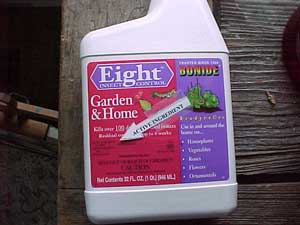Whatever you do decide to use, it must work. It must do the job. If it is “safe” but does not do the job, then why bother taking the time? To be more sure of success you should try to use the best product for the circumstances that has the least impact on the surrounding environment. Here are some guidelines to help you in your decision:
Usually you have several steps to consider before bringing in the big bangers.
In many cases, you don’t need to even think about an insecticide. With insects that are easily trapped such as yellow jackets, flies, and slugs you have traps available. In some cases a barrier will do the job. Check out the recommendations in the individual pest insect file to learn about your options before moving to an insecticide.
Do you try to get the culprit off the plant with a repellent? Repellents may work to cause existing pest insects on a plant to go away. You will know if it worked within a day or two. If there are more symptoms or you can still see the pest insects on the plant, move to a more direct killing tool. Repellents however are very effective after you have controlled the problem or next year on a plant that had a problem this year. Examples of repellents are garlic, hot pepper wax, and neem.
Find The Active Ingredient
Active Ingredient Notice on Label
It is good to know which chemical is used in any bottle of insecticide you buy. It is hard to figure when the product is called something like “Bug Killer” or “Bug Beater”. However, there is one sure way to determine the contents of an insecticide and it works for every insecticide product in the store.
You are looking on the front label of the bottle for a section in teeny tiny print that says “Active Ingredient”.
 |
The Federal pesticide labeling regulations require that the ingredients statement on all pesticide labels (which includes insecticides) use the terms "Active ingredients" and "Inert ingredients" as the headings for the ingredients statement information. An active ingredient is one that prevents, destroys, repels or mitigates a pest, and each active ingredient must be identified by name on the label together with its percentage by weight. An inert ingredient is simply any ingredient in the product that is not pesticidally active. Unless an inert ingredient is determined to be highly toxic, it is not required to be identified by name or percentage on the label, but the total percentage of such ingredients must be declared.
The common problem here is that when you do find that listing of one or more “Active Ingredients”, the words are long chemical terms that are impossible to pronounce much less spell. In many cases, especially with the insecticide products described in Yardener’s Tool Shed, you will find terms that you can pronounce and even spell such as neem, permethrin, and resmethrin.
The Dose Is Important
Along with those unpronounceable names for the Active Ingredients” you will see a number in the form of a percentage. That tells you how much of the product is in fact the actual ”Active Ingredient”. The smaller the percentage, especially for synthetic insecticides, the better. Anything under 5% is generally okay, but under 2% is even better.
We Try To Help
In every product file in Yardener’s Tool Shed for any of the pesticides – insecticides, herbicides, or fungicides – we will up front identify the ”Active Ingredient” and give you a brief explanation in English as to what it is.

